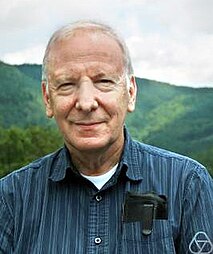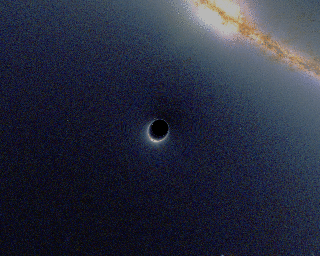Related Research Articles

General relativity, also known as the general theory of relativity, is the geometric theory of gravitation published by Albert Einstein in 1915 and is the current description of gravitation in modern physics. General relativity generalizes special relativity and refines Newton's law of universal gravitation, providing a unified description of gravity as a geometric property of space and time or four-dimensional spacetime. In particular, the curvature of spacetime is directly related to the energy and momentum of whatever matter and radiation are present. The relation is specified by the Einstein field equations, a system of partial differential equations.
In theories of quantum gravity, the graviton is the hypothetical quantum of gravity, an elementary particle that mediates the force of gravity. There is no complete quantum field theory of gravitons due to an outstanding mathematical problem with renormalization in general relativity. In string theory, believed to be a consistent theory of quantum gravity, the graviton is a massless state of a fundamental string.
In general relativity, a naked singularity is a hypothetical gravitational singularity without an event horizon. In a black hole, the singularity is completely enclosed by a boundary known as the event horizon, inside which the gravitational force of the singularity is so strong that light cannot escape. Hence, objects inside the event horizon—including the singularity itself—cannot be directly observed. A naked singularity, by contrast, would be observable from the outside.
Quantum gravity (QG) is a field of theoretical physics that seeks to describe gravity according to the principles of quantum mechanics, and where quantum effects cannot be ignored, such as in the vicinity of black holes or similar compact astrophysical objects where the effects of gravity are strong, such as neutron stars.

A wormhole is a speculative structure linking disparate points in spacetime, and is based on a special solution of the Einstein field equations.

The no-hair theorem states that all black hole solutions of the Einstein–Maxwell equations of gravitation and electromagnetism in general relativity can be completely characterized by only three externally observable classical parameters: mass, electric charge, and angular momentum. All other information about the matter that formed a black hole or is falling into it "disappears" behind the black-hole event horizon and is therefore permanently inaccessible to external observers. Physicist John Archibald Wheeler expressed this idea with the phrase "black holes have no hair", which was the origin of the name. In a later interview, Wheeler said that Jacob Bekenstein coined this phrase.
A gravastar is an object hypothesized in astrophysics by Pawel O. Mazur and Emil Mottola as an alternative to the black hole theory. It has usual black hole metric outside of the horizon, but de Sitter metric inside. On the horizon there is a thin shell of matter. The term "gravastar" is a portmanteau of the words "gravitational vacuum star".

In quantum field theory, a false vacuum is a hypothetical vacuum that is not actively decaying, but somewhat yet not entirely stable ("metastable"). It may last for a very long time in that state, and might eventually move to a more stable state, an event known as false vacuum decay or vacuum metastability event. The most common suggestion of how such a change might happen is called bubble nucleation – if a small region of the universe by chance reached a more stable vacuum, this "bubble" would spread.
Numerical relativity is one of the branches of general relativity that uses numerical methods and algorithms to solve and analyze problems. To this end, supercomputers are often employed to study black holes, gravitational waves, neutron stars and many other phenomena governed by Einstein's theory of general relativity. A currently active field of research in numerical relativity is the simulation of relativistic binaries and their associated gravitational waves. Other branches are also active.
In theoretical general relativity, a geon is a nonsingular electromagnetic or gravitational wave which is held together in a confined region by the gravitational attraction of its own field energy. They were first investigated theoretically in 1955 by J. A. Wheeler, who coined the term as a contraction of "gravitational electromagnetic entity".
The Weyl curvature hypothesis, which arises in the application of Albert Einstein's general theory of relativity to physical cosmology, was introduced by the British mathematician and theoretical physicist Sir Roger Penrose in an article in 1979 in an attempt to provide explanations for two of the most fundamental issues in physics. On the one hand one would like to account for a universe which on its largest observational scales appears remarkably spatially homogeneous and isotropic in its physical properties, on the other hand there is the deep question on the origin of the second law of thermodynamics.

Robert M. Wald is an American theoretical physicist who studies gravitation. His research interests include general relativity, black holes, and quantum gravity. He is also a science communicator and textbook author.
Ni Wei-tou is a Taiwanese physicist, who graduated from the Department of Physics of National Taiwan University (NTU), and got his PhD of Physics & Mathematics from California Institute of Technology. After his retirement on 1 October 2000, he is now appointed as a professor emeritus of the Department of Physics of National Tsing Hua University (NTHU) at Hsinchu, Taiwan, since 2006.
The BTZ black hole, named after Máximo Bañados, Claudio Teitelboim, and Jorge Zanelli, is a black hole solution for (2+1)-dimensional topological gravity with a negative cosmological constant.

Alessandra Buonanno is a theoretical physicist. She is a director at the Max Planck Institute for Gravitational Physics in Potsdam, and head of the "Astrophysical and Cosmological Relativity" department. She holds a College Park professorship at the University of Maryland, College Park, and honorary professorships at the Humboldt University in Berlin, and the University of Potsdam. She is a leading member of the LIGO Scientific Collaboration, which observed gravitational waves from a binary black-hole merger in 2015.
Anzhong Wang is a theoretical physicist, specialized in gravitation, cosmology and astroparticle physics. He is on the Physics faculty of Baylor University. Currently he is working on cosmology in string/M theory and the Hořava-Lifshitz gravity.

Relativistic images are images of gravitational lensing which result due to light deflections by angles .
It was customary to represent black hole horizons via stationary solutions of field equations, i.e., solutions which admit a time-translational Killing vector field everywhere, not just in a small neighborhood of the black hole. While this simple idealization was natural as a starting point, it is overly restrictive. Physically, it should be sufficient to impose boundary conditions at the horizon which ensure only that the black hole itself is isolated. That is, it should suffice to demand only that the intrinsic geometry of the horizon be time independent, whereas the geometry outside may be dynamical and admit gravitational and other radiation.

In astrophysics, an extreme mass ratio inspiral (EMRI) is the orbit of a relatively light object around a much heavier object, that gradually decays due to the emission of gravitational waves. Such systems are likely to be found in the centers of galaxies, where stellar mass compact objects, such as stellar black holes and neutron stars, may be found orbiting a supermassive black hole. In the case of a black hole in orbit around another black hole this is an extreme mass ratio binary black hole. The term EMRI is sometimes used as a shorthand to denote the emitted gravitational waveform as well as the orbit itself.
Ruth Ann Watson Gregory is a British mathematician and physicist, currently Head of Department of Physics and Professor of Theoretical Physics at King's College London. Her fields of specialisation are general relativity and cosmology.
References
- 1 2 "Averill Park Student Wins High Honors", Times Record (Troy, New York), p. 42, April 3, 1974 – via Newspapers.com
- 1 2 3 4 "Jennie Traschen, Ph.D., Harvard University (1984)", Physics Spotlight, UMass Amherst Department of Physics, November 2015, retrieved 2020-07-18
- ↑ Anderson, Malcolm R. (2015), "7.3 The Geroch–Traschen critique", The Mathematical Theory of Cosmic Strings: Cosmic Strings in the Wire Approximation, Series in High Energy Physics, Cosmology and Gravitation, CRC Press, pp. 252–255, ISBN 9781420033366
- ↑ Steinbauer, R.; Vickers, J. A. (February 2009), "On the Geroch–Traschen class of metrics" (PDF), Classical and Quantum Gravity, 26 (6): 065001, arXiv: 0811.1376 , Bibcode:2009CQGra..26f5001S, doi:10.1088/0264-9381/26/6/065001, S2CID 17556918
- ↑ See, e.g.:
- Nakao, Ken-ichi; Shiromizu, Tetsuya; Hayward, Sean A. (July 1995), "Horizons of the Kastor–Traschen multi-black-hole cosmos", Physical Review D, 52 (2): 796–808, Bibcode:1995PhRvD..52..796N, doi:10.1103/physrevd.52.796, PMID 10019300
- Casey, Stephen (May 2012), "Kastor–Traschen black holes, null geodesics and conformal circles", Classical and Quantum Gravity, 29 (13): 135006, arXiv: 1110.2091 , Bibcode:2012CQGra..29m5006C, doi:10.1088/0264-9381/29/13/135006, S2CID 119289057
- Čermák, Martin; Zouhar, Martin (April 2014), "Cosmologically inspired Kastor-Traschen solution", Physical Review D, 89 (8): 084024, arXiv: 1307.7508 , Bibcode:2014PhRvD..89h4024C, doi:10.1103/physrevd.89.084024, S2CID 119119828
- McNutt, David; Coley, Alan (September 2018), "Geometric horizons in the Kastor–Traschen multi-black-hole solutions", Physical Review D, 98 (6): 064043, arXiv: 1811.02931 , Bibcode:2018PhRvD..98f4043M, doi:10.1103/physrevd.98.064043, S2CID 119401880
- ↑ Tod, K. P. (December 1988), "The integral constraint vectors of Traschen and three-surface twistors", General Relativity and Gravitation, 20 (12): 1297–1308, Bibcode:1988GReGr..20.1297T, doi:10.1007/bf00756055, S2CID 121487436
- ↑ Perlick, Volker (August 1998), "Book review: Gravitation and Cosmology", General Relativity and Gravitation, 30 (8): 1293–1295, doi:10.1023/a:1026659331443, S2CID 118311083
- ↑ APS Fellows Nominated by DGRAV: 2006, APS Division of Gravitational Physics, retrieved 2020-07-18
- ↑ "Amherst, Massachusetts Battles Over Flag-Flying", CNN Sunday Morning, CNN, October 14, 2001
- 1 2 Guidera, Jerry; Tomsho, Robert (October 2, 2001), "How Words Spoken on Sept. 10 Came Back to Haunt the Speaker", The Wall Street Journal
- 1 2 Science Scene: Cosmological spacetime, 'dark energy', and women in physics; Physicist Jennie Traschen helps diversify her field on an international stage, UMass Amherst College of Natural Sciences, November 9, 2018, retrieved 2020-07-18
- ↑ "Looking back", Laredo Morning Times , January 5, 2018
- ↑ "Susan Kastor", Amherst Bulletin, May 2015
- ↑ Kastor, Kalyani, About me , retrieved 2020-07-18